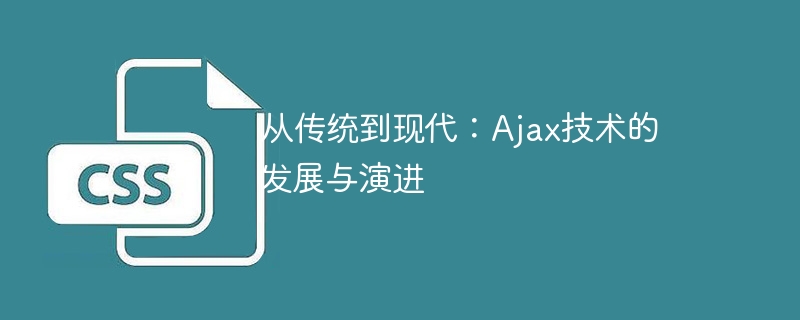

From tradition to modernity: the development and evolution of Ajax technology
Introduction:
With the development of the Internet, web design and development are also constantly evolving. Traditional web pages transmit and display data through page refresh between the user and the server. This method has many inconveniences and efficiency problems. The emergence of Ajax (Asynchronous JavaScript and XML) technology has completely changed the way traditional web pages work, providing a faster and more efficient interactive experience. This article will explore the development and evolution of Ajax technology from tradition to modernity, while providing specific code examples.
1. Limitations of traditional web pages
In traditional web design, the interaction between the user and the server is mainly achieved through page refresh. When the user needs to submit form data or request server data, the web page will be reloaded, which leads to an unsmooth user experience and low efficiency. In addition, when traditional web pages process large amounts of data, they will generate a lot of network traffic and server pressure.
2. Introduction to Ajax technology
Ajax technology realizes real-time asynchronous data interaction and user interface updates without page refresh by utilizing JavaScript, XMLHttpRequest and back-end services. The core idea is to split a web page into multiple independent components, each component is responsible for handling specific data requests and updates. Through asynchronous requests, Ajax technology allows web pages to interact with the server in the background and dynamically update the acquired data.
3. Advantages and applicable scenarios of Ajax
4. Development and evolution of Ajax technology
var xmlhttp=new XMLHttpRequest();
xmlhttp.open("GET","example.php",true);
xmlhttp.onreadystatechange=function(){
if(xmlhttp.readyState==4 && xmlhttp.status==200){
document.getElementById("result").innerHTML=xmlhttp.responseText;
}
}
xmlhttp.send();$.ajax({
url: "example.php",
method: "GET",
success: function(response){
$("#result").html(response);
},
error: function(xhr, status, error) {
console.log(xhr.responseText);
}
});fetch('example.php')
.then(response => response.text())
.then(data => {
document.getElementById("result").innerHTML = data;
})
.catch(error => {
console.log(error);
});5. Conclusion
From tradition to modernity, the development and evolution of Ajax technology has brought huge changes to Web development. Through asynchronous requests and partial refresh, Ajax technology provides a smoother and more efficient interactive experience, and reduces network overhead and server load. The traditional XMLHttpRequest was replaced by the more convenient jQuery Ajax method, and the emerging Fetch API is even better in simplicity and functionality. With the continuous development of technology, people's demand for Ajax technology will become higher and higher. Whether we are developing web pages, mobile applications or single-page applications, Ajax technology can provide us with a better user experience and more efficient data interaction.
The above is the detailed content of Ajax technology: the development and evolution of tradition and modernity. For more information, please follow other related articles on the PHP Chinese website!




